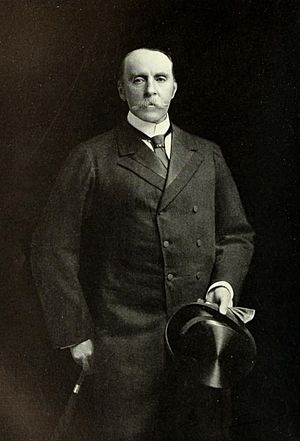Mortimer Durand facts for kids
Quick facts for kids
Sir Henry Mortimer Durand
GCMG, KCSI, KCIE
|
|
|---|---|

Durand, c. 1903
|
|
| Born | 14 February 1850 Sehore, Bhopal State
|
| Died | 8 June 1924 (aged 74) Polden, Somerset, United Kingdom
|
Sir Henry Mortimer Durand (born February 14, 1850 – died June 8, 1924) was an important British diplomat. He worked for the British government in India and later represented his country in other parts of the world. A diplomat helps keep peace and good relations between different countries.
Contents
Early Life and Education
Henry Mortimer Durand was born in Sehore, Bhopal, India. His father was Sir Henry Marion Durand, who was a British official in India. Young Henry went to school in England. He studied at Blackheath Proprietary School and Tonbridge School.
A Career in Public Service
Sir Henry Mortimer Durand began his career in 1873. He joined the Indian Civil Service, which was a group of officials who helped govern British India.
Working in Diplomacy
Durand served as a political secretary in Kabul. This was during the Second Anglo-Afghan War (1878–1880). From 1884 to 1894, he was the Foreign Secretary of India. This meant he handled important international matters for India.
In 1894, he became the British Minister in Tehran, Persia (now Iran). Even though he knew the Persian language well, his time there was difficult. He left Persia in 1900.
After that, he became the British Ambassador to Spain from 1900 to 1903. Then, he served as the Ambassador to the United States from 1903 to 1906. An ambassador is the highest-ranking diplomat representing a country in another country.
Honors and Awards
Sir Henry Mortimer Durand received several important honors for his service. These included:
- CSI in 1881
- KCIE in 1888
- KCSI in 1894
- GCMG in 1900
Writing and Books
After returning to England in 1906, Sir Henry Mortimer Durand spent his time writing. He wrote about history and also tried his hand at novels. Sometimes, his wife, Lady Ella R. Durand, helped him write.
Some of his well-known books include:
- Nadir Shah: An Historical Novel (1908)
- The Life of Sir Alfred Comyn Lyall (1913)
- The Life of Field-Marshal Sir George White, V.C. (1915)
- The Thirteenth Hussars in the Great War (1921)
His wife, Ella R. Durand, also wrote a book called An Autumn Tour in Western Persia (1902).
Lasting Legacy
Sir Henry Mortimer Durand left behind two important legacies that are still known today.
The Durand Line: A Border Story
The Durand Line is a border named after Sir Mortimer Durand. It marks the international boundary between Afghanistan and modern-day Pakistan. Most countries recognize this border, but Afghanistan does not officially agree with it. This makes it a point of discussion between the two nations.
In 1893, Sir Mortimer Durand was sent to Kabul. His mission was to help settle the border between British India and Afghanistan. He met with Abdur Rahman Khan, who was the ruler of Afghanistan at the time. They worked together to agree on where the border should be. This agreement helped prevent bigger conflicts in the region. The Durand Line was officially drawn by a special commission.
The Durand Cup: A Football Tournament
In 1888, Sir Mortimer Durand started a football (soccer) tournament in Shimla, India. He wanted to encourage sports and healthy competition. This tournament was later named the Durand Cup in his honor. It is one of the oldest football tournaments in the world.
His Final Resting Place
Sir Henry Mortimer Durand passed away on June 8, 1924. He died in Polden, Somerset, England, and was buried there. Sometimes people mistakenly think he is buried in Pakistan, but that grave actually belongs to his father, Sir Henry Marion Durand.

